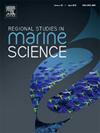Occurrence of pharmaceuticals and cocaine in liver and muscle of different fish species from a Brazilian coastal zone
IF 2.4
4区 环境科学与生态学
Q3 ECOLOGY
引用次数: 0
Abstract
The objective of the present study was to evaluate, for the first time, the occurrence of twelve pharmaceutically active compounds (PhACs) in the livers and muscles of five fish species in a Brazilian coastal zone. The species (Cathorops spixii, Genidens genidens, Bagre marinus, Larimus breviceps and Pellona harroweri) were selected based on their habitat, and presence in the human diet within the aforementioned coastal zone. The results demonstrated the presence of acetaminophen (ACE), benzoylecgonine (BEN), caffeine (CAF), cocaine (COC), and furosemide (FUR) in the fish tissues, with concentrations ranging from the limit of quantification (LOQ) to 9.17 ng g−1. A comparative analysis of the species revealed that C. spixii exhibited the highest accumulation of pharmaceutical agents in both muscle and liver tissues. In particular, the detection of ACE (a compound with low lipophilicity) was observed exclusively in the muscle of C. spixii. Despite its low lipophilicity, the concentrations of CAF were quantified in B. marinus at a level higher than those in C. spixii, G. genidens and L. breviceps. One potential explanation for this observed bioaccumulation of CAF in these species is the historical detection of high concentrations of this compound in this coastal zone. Furthermore, the observed discrepancy between the high levels of COC in relation to BEN in the tissues of C. spixii and L. breviceps can be attributed to the low lipophilicity of BEN and moderate hydrophobicity of COC. Ultimately, the observed contamination has the potential to result in secondary human exposure to PhACs.
巴西沿海地区不同鱼类肝脏和肌肉中药物和可卡因的含量
本研究的目的是首次评估巴西沿海地区5种鱼类肝脏和肌肉中12种药物活性化合物(PhACs)的存在。根据其栖息地和在上述海岸带人类饮食中的存在情况,选择了这些物种(毛蕨、草属植物、海螺、短尾螺和海螺)。结果表明,鱼组织中存在对乙酰氨基酚(ACE)、苯甲酰茶碱(BEN)、咖啡因(CAF)、可卡因(COC)和速尿(FUR),其浓度范围从定量限(LOQ)到9.17 ng g−1。比较分析表明,螺旋螺旋体在肌肉和肝脏组织中均表现出最高的药物积累。特别是,ACE(一种低亲脂性的化合物)的检测仅在螺旋体的肌肉中观察到。尽管CAF的亲脂性较低,但在海洋小蠊中的CAF含量高于螺旋螺旋体、属草和短叶螺旋体。在这些物种中观察到的CAF生物积累的一个可能的解释是,历史上在该沿海地区检测到高浓度的这种化合物。此外,在螺旋螺旋体和短叶螺旋体组织中,高水平的COC与BEN之间的差异可能归因于BEN的低亲脂性和COC的中等疏水性。最终,观察到的污染有可能导致人类二次暴露于phac。
本文章由计算机程序翻译,如有差异,请以英文原文为准。
求助全文
约1分钟内获得全文
求助全文
来源期刊

Regional Studies in Marine Science
Agricultural and Biological Sciences-Ecology, Evolution, Behavior and Systematics
CiteScore
3.90
自引率
4.80%
发文量
336
审稿时长
69 days
期刊介绍:
REGIONAL STUDIES IN MARINE SCIENCE will publish scientifically sound papers on regional aspects of maritime and marine resources in estuaries, coastal zones, continental shelf, the seas and oceans.
 求助内容:
求助内容: 应助结果提醒方式:
应助结果提醒方式:


